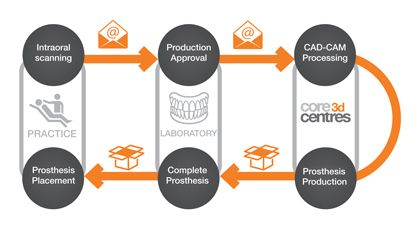How to handle digital files from your dental clients
The word’s out! Digital dentistry is no longer a dream. It isn’t about the future. It is here and now. It is here to stay. Unfortunately, as with any fast-evolving methodology, doctors have an abundance of choices to handle their digital requirements.
The word’s out! Digital dentistry is no longer a dream. It isn’t about the future. It is here and now. It is here to stay. Unfortunately, as with any fast-evolving methodology, doctors have an abundance of choices to handle their digital requirements.
As is usually the case, it is now up to the lab to have a solution that allows them to handle all these different digital file formats. What complicates the situation is that most technicians are under the misguided notion that any open laboratory CAD system can read all open STL files. Unfortunately, that is certainly not the case. At Core3dcentres, as we have gained experience with the STL files created by different systems, we have found that they are anything but the same. This begs the question: What is a lab to do?
As with all aspects of the relationship between clinician and laboratory, the key to success is extensive communication. For a lab to be ready to accept digital cases, it certainly helps to know what system the files are going to be originating from-and well before the cases start coming in! The optimal situation is to be able to guide the doctor to a system in which the laboratory has confidence. Unfortunately, this is not always possible. Labs are often left to gather information about the system and files when the clock is already ticking on a case. This process includes what we might consider basic information on case options. Does the case need a model? How will the restoration be manufactured? What material is requested or required on the case?
Bridge & crown simplicity
For typical crown and bridge, the answers to these questions can be simplified. Monolithic restorations can be fabricated without a model-end of story. The question I am asked most often is “can a lab guarantee fit of a restoration without a model?” The easy answer is yes. However, this can require a bit of a leap of faith. Labs have fabricated restorations without models, but had trouble fitting them to the model they then receive for the case. What happened?
Through a series of tests, we have determined the cause of this is more likely inaccuracies in the model, not in the restorations. Depending on fabrication of these models, different types of inaccuracies can occur. The thing to remember here is that the digital data collected from the intraoral scanner is the most accurate data to work from. With proper parameters in the design software, a lab should have the utmost confidence that modeless restorations can be counted on to fit. This goes back to communication between the lab and doctor as to how the restorations are working in the mouth.
Where it gets complicated
That being said, when these cases start to involve implants, the workflow gets a little harder to decipher. The start of the data collection process here should be “where the doctor purchased the scan body.” Once that information is verified, the next step is to follow up with the scan body manufacturer.
Scan bodies are connected to implant libraries-and are not able to be used without their particular library if you want to achieve an accurate result. Depending on the implant library, it may, or may not, be possible to fabricate a model. There are also different types of models that can be created. Some libraries have the ability to print a model with a socket for a lab analog to embed in, while others only have the ability to print the model with a replica of the designed implant abutment. The best place to determine this, and the rest of the workflow, would be the manufacturer of the implant library.

The “unspoken factor” in digital workflow is always the scanner the doctor uses. With the variety of scanners on the market, doctors have many choices and many different reasons for making their decisions. Some doctors wish to also take on in-house manufacturing; this does not mean they won’t still send some work to their labs. The ability to work with these cases often requires additional software for the lab. Some of the scan-only intraoral scanners also require that the data runs through additional software before it becomes usable in particular laboratory CAD design software. The key point? Differences in scanners represent, for the most part, differences in workflow.
Core3dcentres has the in-depth experience and ability to work with scan data from all the major intraoral scanners, and the additional software to make that data usable for laboratories. We also have an implant library that has the versatility to make models with embedded implant replicas, allowing labs to retain their current workflow. Perhaps most important of all, we also provide training through our Core3daCADemy™ and the on-demand technical assistance that helps labs help themselves.
Photos: Top photo-a-r-t-i-s-t / Getty Images (top). Workflow image courtesy of Core3dcentres.
Product Bites – January 19, 2024
January 19th 2024Product Bites makes sure you don't miss the next innovation for your practice. This week's Product Bites podcast features new launches from Adravision, Formlabs, Owandy Radiology, Henry Schein Orthodontics, Dental Creations, and Dental Blue Box. [5 Minutes]
Product Bites – December 22, 2023
December 22nd 2023The weekly new products podcast from Dental Products Report is back. With a quick look at all of the newest dental product launches, Product Bites makes sure you don't miss the next innovation for your practice. This week's Product Bites podcast features updated software from Medit. [2 Minutes]